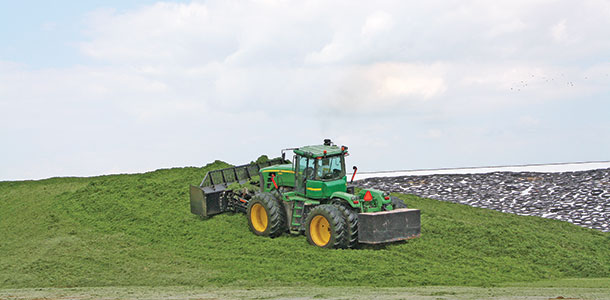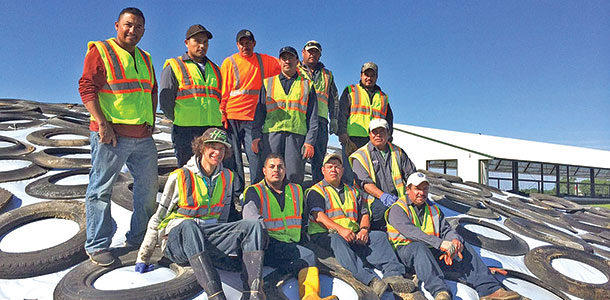Trucks, tractors and tons of feed make harvest season a busy time on dairies – and potentially a dangerous one, too. Juan Quezada, director of safety and training at Milk Source, strives to keep employees out of harm’s way while putting up large volumes of forage. The dairy located in Kaukauna, Wisconsin, handles roughly 360,000 tons of corn silage, 130,000 tons of haylage and 50,000 tons of sorghum silage per year.
“When it comes to pile building, the key is paying attention to your surroundings,” Quezada explains. “When somebody approaches the feed pile, we try to keep them a safe distance from the tractors. And we’ll often take our feed samples from the smaller piles so we don’t have to get unnecessarily close to the tractors (working on the large piles).”
He also suggests establishing eye contact with truck and equipment drivers. “Don’t assume that the driver can see you,” he says.
Further, Milk Source requires that people working outside wear safety vests at all times. This is especially important during fall harvest as daylight dwindles and crews start running before sunrise.
“With our safety vests, you can see the employee from far away,” Quezada notes. “That’s especially important for the people who work near the tractors.”

Bunker safety tips: Covering and packing bunkers safely
By Chris Wacek-Driver, Vita Plus forage program manager
- If you don’t have a reason to be at the face or top of a bunker or pile, don’t be there. Even well-packed bunkers have the potential to collapse. Proceed with caution and never work alone when packing and covering bunkers. When taking a sample, use an end loader to scoop the silage and move it to a safe distance from the face or pile for sampling.
- All packing tractors should have roll-over protection, seatbelts and intact cabs. Remember, seatbelts are only effective when they are used.
- Silo gas (NO2) poisoning is not limited to upright silos; it can also be a danger with bunkers and piles. Maximum NO2 production occurs in the first three to five days after silage is put up. This gas is dense, so exposure risk is greatest at the bottom of the bunker or pile. If at all possible, stay away from this area for the first 21 days to limit exposure potential.
Storage bin safety tips: Reminders on safely working in these environments
By Joe Bohl, Vita Plus Fall River operations supervisor
- Use the “buddy system.” Never enter a bin alone, and only enter with the proper safety gear. Make sure you have a mobile phone available to call emergency services immediately if needed.
- Follow a lockout/tagout procedure for all filling and unloading equipment. Make sure all members of your team are trained on these procedures and understand their importance.
- Keep all belt and auger safety shields in place. While it may seem helpful to remove them, machinery is equipped with shields for a reason – to keep you safe.
- Keep children away from bins, equipment and machinery. Kids don’t understand the hazards of harvest and can easily end up in the wrong place at the wrong time.
Worker safety: Safety vests save lives
By Scott Hall, Vita Plus safety director
- Stay visible at all times, especially when you have a large number of workers in and around equipment, facilities and vehicles.
- Make sure all workers wear high-visibility clothing in any area with traffic or moving vehicles and equipment. This increases machinery operators’ ability to spot workers on the ground.
- Wear lime-green clothing in the daylight and reflective material for night or low-light conditions.
- Safety vests are a great option because they are lightweight and easy to remove. That said, make sure the vests are well-fitted to reduce your chances of getting clothing caught in moving parts. T-shirts, jackets, raincoats, pants, hats, gloves and more are also available in high-visibility materials. PD

Peggy Coffeen
Editor
Progressive Dairyman







